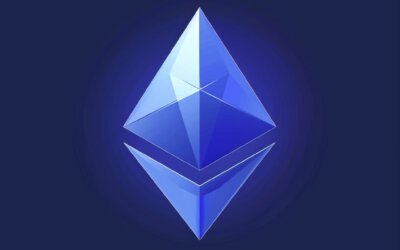How Old Is Ethereum? Ethereum’s History Explained

Key Takeaway:
- Ethereum is a decentralized, open-source blockchain platform that enables smart contracts and decentralized applications (dapps) to be built and run without downtime, fraud, or interference from a third party.
- The native coin of Ethereum is Ether (ETH), which is used to pay for transaction fees and computational services on the network.
- Ethereum was founded in 2014 by Vitalik Buterin, Gavin Wood, and other contributors. Since then, Ethereum has undergone several updates and improvements, including the transition to Proof-of-Stake (PoS) consensus mechanism and the implementation of the Beacon Chain update for scalability.
Introduction to Ethereum
As I delve into the world of blockchain, Ethereum has piqued my interest as one of the most popular cryptocurrencies. I’ve been curious about its history, how Ethereum differs from Bitcoin, and how it works. In this segment, we’ll explore Ethereum from the ground up, starting with a brief definition and characteristics. Next, we’ll peer into the native coin of Ethereum, Ether (ETH), and how it has evolved over the years. Finally, we’ll examine the Ethereum Foundation, which serves as the technical and bureaucratic backbone of the Ethereum platform. So, buckle in and let’s explore the fascinating world of Ethereum!
Definition and characteristics
Ethereum is a blockchain platform that allows developers to build and deploy decentralized applications. It’s widely known for its smart contracts, which are self-executing contracts with the terms of the agreement between buyer and seller, written into lines of code. Ethereum has several unique characteristics that set it apart from other blockchains.
- Ethereum uses its native coin called Ether (ETH) as a fuel to run transactions on the network, making it more efficient and faster than traditional payment systems.
- Ethereum is designed to be more flexible than Bitcoin, allowing developers to create custom tokens and execute complex operations on the blockchain. Finally, Ethereum has a larger community and developer ecosystem than many other blockchains, which has resulted in widespread adoption.
Despite its many advantages, Ethereum faces scalability issues due to its limited capacity for processing transactions. This issue is particularly pertinent given the recent surge in popularity of decentralized finance (DeFi) applications built on the Ethereum platform.
To tackle this problem, there have been proposals for shifting from the current Proof-of-Work consensus mechanism to Proof-of-Stake (PoS), which requires significantly less computational power and could increase scalability. The planned Beacon Chain update promises to bring significant changes towards achieving this goal.
In summary, Ethereum’s definition and characteristics make it a uniquely versatile blockchain platform that can facilitate large-scale applications like DeFi while still being flexible enough to allow developers unlimited creativity with smart contracts on its network. As such, it is worthwhile exploring how solutions like PoS would provide effective solutions for scaling up while maintaining security across all use cases in the future of Smart Contracts’ implementation.
Ethereum’s ETH may be the currency of the future, but for now it’s just paying the bills for Vitalik’s ramen.
Ethereum’s native coin: Ether
Ethereum’s native token is called Ether (ETH), which is the second-largest cryptocurrency by market capitalization after Bitcoin. ETH serves as a fuel for Ethereum’s blockchain platform, allowing users to operate smart contracts and decentralized applications (dApps) on the network. Ether can also be used to pay transaction fees or exchange for other cryptocurrencies or fiat currency. Unlike Bitcoin, whose finite supply is fixed at 21 million, Ethereum currently has no fixed supply limit but employs a set inflation rate.
Additionally, ETH holders play a crucial role in securing the network by participating in the consensus process via mining or staking. The latter involves locking up their ETH holdings in a validating node and receiving rewards for verifying transactions. The upcoming transition from Proof-of-Work to Proof-of-Stake consensus algorithm aims to improve scalability and energy efficiency, further boosting ETH demand.
Furthermore, despite scalability challenges faced by Ethereum due to its popularity among DeFi applications, Ethereum’s network effect continues growing stronger with over 10K dApps deployed and millions of active users globally.
Interestingly, notably different from BTC’s pseudonymous creator Satoshi Nakamoto Ethereum was created in 2015 by Vitalik Buterin – a Russian-Canadian computer programmer – as an open-source blockchain platform through crowdfunding raising $18M worth of Bitcoin during his Initial Coin Offering (ICO). The Ethereum Foundation holds the reins of the world’s second-largest cryptocurrency, making it the ultimate hodler.
Ethereum Foundation
One of the foundation’s critical goals is to ensure that Ethereum remains decentralized and open-source. To achieve this goal, they have created various governance structures that allow for community input and decision-making. They also fund independent audits of key components of the platform to ensure that they are secure.
The Ethereum Foundation has been a driving force behind some of the most significant developments in the blockchain industry, such as smart contracts and decentralized applications (dapps). With its support, Ethereum has become one of the most successful blockchain platforms worldwide attracting widespread attention from both developers and investors.
Pro Tip: The Ethereum Foundation offers numerous resources like online forums, documentation libraries, educational materials such as whitepapers that can help improve your knowledge about Ethereum Foundation technology.
Ethereum’s early days were like a toddler learning to walk, stumbling through updates and ICOs.
Ethereum’s Early Days
Looking back at the early days of Ethereum is like exploring the birthplace of a technology that has now grown up and left home. It’s fascinating to see the genesis of ideas that have made this public blockchain network so popular today. So, let’s take a trip back in time to learn about the founders of Ethereum who laid the foundation for what was to become the most popular smart contract platform around. We’ll explore how Vitalik Buterin’s whitepaper became the blueprint for Ethereum, and delve into the Ethereum Initial Coin Offering (ICO) that generated the funding to make it all a reality.
Founders of Ethereum
The inception of Ethereum is credited to a group of individuals who collectively designed and built the platform. These pioneers shared a vision of creating a blockchain-based network that could support smart contracts and decentralized applications (dapps). The founders of Ethereum include Vitalik Buterin, Gavin Wood, Joseph Lubin, Jeffrey Wilcke, and Charles Hoskinson.
Vitalik Buterin is widely regarded as the face of Ethereum. He authored the original white paper conceptualizing Ethereum in 2013 and played an instrumental role in its development since then. Gavin Wood was responsible for designing the Solidity programming language used to build dapps on Ethereum. Joseph Lubin co-founded ConsenSys, which has become one of the biggest companies building on top of Ethereum’s platform. Jeffrey Wilcke helped create Geth, one of the primary client implementations used to interact with Ethereum nodes. Lastly, Charles Hoskinson contributed significantly to Ethereum’s development before departing in 2014.
The founders’ unique backgrounds helped shape Ethereum’s architecture and philosophy. Their collective expertise in computer science, cryptography, finance, economics and entrepreneurship came together to create what we know today as Ethereum.
Ethereum continues to evolve through updates like Byzantium and Constantinople upgrades leading up to the rollout of Beacon Chain; all trying to resolve underlying scalability issues that haunted its early days.
Don’t get left behind – stay up-to-date with developments related to ethereum’s history intertwined with interesting stories such as The DAO Hack!
Vitalik Buterin’s white paper on Ethereum revolutionized the way we think about blockchain and smart contracts.
Vitalik Buterin’s white paper
In October 2013, Vitalik Buterin’s white paper on Ethereum, a decentralized platform for building applications, was published. The paper introduced the concept of smart contracts and highlighted the potential benefits of blockchain technology beyond just cryptocurrency transactions. It also proposed a new consensus mechanism called Proof-of-Stake (PoS) that would eventually replace Proof-of-Work (PoW) to address scalability issues.
Ethereum’s white paper was considered groundbreaking in the blockchain industry and attracted a lot of attention from developers and investors. In response to the interest generated by the white paper, Buterin co-founded Ethereum with a group of developers to turn his vision into reality.
One unique detail about Vitalik Buterin’s white paper is that it envisioned Ethereum as not just a financial system but also as a platform for building decentralized applications. This approach proved to be innovative and led to an explosion of dApps built on top of the Ethereum blockchain.
To continue innovating, Ethereum needs to address its scalability challenges caused by network congestion and high gas fees. One suggestion is to switch from PoW to PoS consensus mechanism, which will greatly reduce energy consumption and increase throughput capacity. Another suggestion is to implement layer two scaling solutions such as rollups or sidechains that can process transactions off-chain while still benefitting from Ethereum’s security guarantees. By applying these suggestions, Ethereum can continue pushing the boundaries of blockchain technology and enabling new use cases for decentralization.
ICO or Initial Coin Offering, aka the crypto version of a Kickstarter campaign, helped Ethereum raise over $18 million in just 42 days.
Ethereum Initial Coin Offering
During its early days, Ethereum conducted an initial coin offering (ICO), a crowdfunding campaign where the public could purchase Ether (ETH) tokens in exchange for Bitcoin or other cryptocurrencies. This generated funds for the development of the platform and allowed investors to own part of the network. The ICO was launched in July 2014, and within 42 days, it raised over $18 million worth of Bitcoin and other currencies. This ICO is considered one of the most successful in history, paving the way for many other ICOs to follow in the cryptocurrency industry.
Investors who participated in Ethereum’s initial coin offering (ICO) reaped substantial gains as ETH rose from its initial market price. Today, missing out on an ICO like Ethereum’s can be a regretful experience for investors looking to maximize returns on their investments. As such, learning about potential ICOs early on is essential to make informed investment decisions and reap maximum benefits.
Ethereum’s progress is like a caterpillar going through different stages, eventually blossoming into a beautiful butterfly on the Beacon Chain.
Ethereum’s Stages of Progress
I’ve always been fascinated by the evolution of Ethereum. Understanding the journey of a digital milestone can help us appreciate its present and potential future. One of the best ways to explore this is by examining the stages of progress that Ethereum has gone through. In this section, we’ll take a look at three key updates that have shaped Ethereum’s history – the Frontier, Byzantium and Constantinople updates, and the Beacon Chain update. These updates represent significant milestones in Ethereum’s journey towards becoming a more robust and decentralized network.
Frontier
During its early days, Ethereum went through a stage known as the ‘frontier’ phase. This phase was marked by a release of the first version of the Ethereum network in July 2015. It was characterized by limitations such as high transaction fees and slow processing times. Developers were encouraged to test and experiment with the network in this phase, which laid the groundwork for subsequent updates.
Despite these limitations, the frontier phase marked an important step towards achieving Ethereum’s vision of creating a decentralized platform that enables developers to build applications and smart contracts on a blockchain-based infrastructure. The release of the frontier version provided developers with a platform to start testing their ideas and developing decentralized applications.
The frontier phase paved the way for subsequent updates such as Byzantium and Constantinople, which aimed to address some of Ethereum’s scalability issues by introducing new features like Proof-of-Stake consensus mechanism and sharding. These updates helped enhance the speed and efficiency of transactions on the Ethereum network.
A true fact: The Ethereum network has been in operation for over six years since its release in July 2015.
Ethereum’s Byzantium and Constantinople updates brought improvements to its infrastructure, but still couldn’t fix my ex-girlfriend’s Byzantine behavior.
Byzantium and Constantinople updates
Ethereum underwent significant updates with Byzantium and Constantinople. These upgrades introduced new features, improved scalability, stability, and security. Specifically, Byzantium implemented new mathematical operations in Ethereum Virtual Machine (EVM) as well as modified the difficulty algorithm to reduce ASIC dominance. Constantinople introduced several important Ethereum Improvement Proposals (EIPs), including lower gas costs for specific functions and an increase in Ether issuance reduction. In these upgrades, Ethereum’s ecosystem also benefited from increased dApp usage and faster transaction speeds.
Pro Tip: Stay up-to-date with Ethereum’s progress by regularly checking EIPs to follow changes and upgrade announcements.
Ethereum’s Beacon Chain update proves that progress waits for no blockchain.
Beacon Chain update
Ethereum underwent a major transition with the Beacon Chain update, which represents the first phase in its transition to Ethereum 2.0. The Beacon Chain is essentially a new blockchain that operates parallel to the existing Ethereum chain and enables features such as staking and sharding. This update marks a significant step towards improving scalability and enhancing network speed, while also allowing for greater participation from validators.
With Beacon Chain’s update, Ethereum moves towards Proof-of-Stake consensus mechanism, where users can validate transactions by staking ETH tokens instead of using proof-of-work consensus algorithm. While the current Ethereum blockchain can only process around 15 transactions per second, this upgrade could allow for tens of thousands of transactions per second.
The Beacon Chain update also introduces new features like the ability to stake Ether into validator nodes on the network and earn interest on those holdings. Validators help secure the network and maintain consensus on transaction blocks, making them an essential component of Ethereum’s ecosystem.
This groundbreaking update has been long-awaited by the crypto community and highlights Ethereum’s continual efforts to stay at the forefront of blockchain technology advancements. Once fully implemented, this upgrade will provide greater scalability to support continued growth in decentralized finance (DeFi) projects built on top of its platform.
History shows us that when it comes to technological advancements in blockchains innovation never stops as developers continue pushing boundaries through updates like Beacons’ chain that aim at improving scalability and enhancing network speed delivering more usability for end-users.
Ethereum’s scalability is like a marathon runner stuck in traffic: it’s not going anywhere fast without a major upgrade.
Ethereum’s scalability issues
As someone who is invested in the world of cryptocurrency, I can attest to the incredible impact that Ethereum has had on the industry. However, as the platform has grown in popularity, it has struggled to address its scalability issues. In order to truly understand what this means and how it affects the future of Ethereum, we need to examine two key sub-sections:
- Decentralized finance (DeFi) and Ethereum
- The shift to Proof-of-Stake (PoS)
By looking closely at these topics, we can gain a better understanding of Ethereum’s past, present, and future. According to recent reports, the Ethereum network now processes more than 1.2 million transactions per day, highlighting the urgency of addressing these scalability concerns.
Decentralized finance and Ethereum
The emergence of decentralized finance (DeFi) as a new financial system is not only revolutionizing money and the way people use it but also Ethereum and its blockchain. The DeFi market offers a wide range of decentralized applications such as lending, borrowing, trading, and stablecoins built on top of Ethereum’s smart contract capabilities. This new trend depends heavily on Ethereum as most of the DeFi applications are running on its blockchain, making it the most extensive ecosystem for Decentralized Finance.
One crucial factor in DeFi applications using Ethereum is its ERC-20 standard that facilitates token creation. Tokens can represent anything from currency to voting rights or even ownership of physical assets. It has given rise to many innovations like MakerDAO which uses Ether collateral to mint Dai stablecoins.
Like all innovations, one problem that arose when implementing DeFi on Ethereum was scalability as it has been a bottleneck until this point, restricting its usage and utility within the finance world.
To make DeFi available to more users and scale the network further, transitioning from Proof-of-Work (PoW) to Proof-of-Stake (PoS) seems an inevitable conclusion. PoS will enable more efficient transactions where validators are chosen based on their stake instead of computational power – requiring less energy consumption; hence more environmentally sound.
By incorporating sharding techniques through ETH 2.0 update Beacon chain additional improvements could be seen in scalability attaining better TPS (Transactions-per-second), improved security due to parallel processing, making positive strides in handling congestion issues.
Ethereum is shifting to Proof-of-Stake, leaving behind Proof-of-Work like a cheating ex who drained your energy and resources.
Shift to Proof-of-Stake
Ethereum has shifted from the previous consensus mechanism of Proof-of-Work (PoW) to Proof-of-Stake (PoS), facilitating a more efficient and sustainable network. The transition is called the ‘shift to proof-of-stake (PoS)‘. With PoS, validators stake their funds instead of using computational power to solve cryptographic puzzles. They are then responsible for approving transactions and adding new blocks to the blockchain. PoS offers higher scalability, lower energy consumption, reduced centralization risks, and increased network security.
The move to PoS started with the Beacon Chain update, which launched in December 2020, and enabled staking on Ethereum’s network. In contrast, publicly available data now shows that roughly 5 million Ether tokens worth about $13 billion have been deposited on Ethereum 2.0’s Eth2 deposit contract thus far. As the Beacon Chain is currently operating alongside Ethereum’s PoW chain renamed as Etheruem1.x or just Ethereum(Eth1.x), developers will continue gradually rolling out upgrades through a series of hard forks.
The development team behind Ethereum plans to tackle its current scalability issues with new scaling solutions like sharding or creating smaller groups of nodes that validate transactions in an iteration across networks in “parallel.” Additionally, rollups are another scaling solution that may shift computation off-chain while maintaining the cryptographic assurances found on Ethereum’s base layer. Rollups work by compressing many on-chain interactions into a single transaction sent from an aggregator node.
A unique aspect of Ethereum’s shift towards PoS is its potential involvement in decentralized finance (DeFi). Many DeFi protocols operate on top of Ethereum because it allows them to leverage smart contracts that automate trustworthy financial procedures traditionally handled by intermediaries such as banks or clearinghouses. The shift towards PoS could reduce congestion and mitigate transaction fees associated with DeFi applications.
According to CoinMarketCap data until August 2021 – Bitcoin(BTC) sits at no.1 position with $876.71 billion market capitalization followed by Ethereum(ETH) at the second position ($344.37B), while USDC, BNB, and SOL are other significant cryptocurrencies in the market.
(Source – https://coinmarketcap.com/)
It’s like the DAO said to Ethereum: ‘You had one job, and you couldn’t even secure me.’
The DAO Hack
As I dug deeper into the fascinating history of Ethereum, I learned about an event that shook the blockchain community to its core: the DAO hack. Decentralized autonomous organizations (DAOs) were a new concept at the time, and their vulnerabilities became apparent with the arrival of a specific DAO called, simply, the DAO. But it was the hack that occurred in 2016 and the controversial fork solution that made it possible to recover lost funds that really put DAOs in the spotlight. Let’s examine the DAO hack and its aftermath, including the resolution that created Ethereum Classic.
Decentralized autonomous organizations
One example of a specific DAO was The DAO, which raised over $150 million in Ethereum during its initial coin offering (ICO) in 2016. However, it was hacked shortly after and lost millions of dollars’ worth of cryptocurrency. This event led to a hard fork of Ethereum’s blockchain and created two separate versions: Ethereum Classic and the current version of Ethereum.
Pro Tip: DAOs can offer a new level of transparency, efficiency, and decentralization in organization management. However, proper security measures must be taken to avoid potential hacking incidents like The DAO hack.
You know a project is in trouble when even its name is pluralized.
The DAO, a specific DAO
A specific DAO named ‘The DAO‘ was a decentralized autonomous organization launched on the Ethereum blockchain. It raised a significant amount of money during its ICO, becoming one of the largest crowdfunding campaigns in history. The DAO aimed to use smart contracts to facilitate investment and decision-making processes without the need for intermediaries. However, it suffered a major hack in June 2016, resulting in the loss of approximately $50 million worth of Ether, and causing chaos within the Ethereum community.
Following the hack, various proposals were put forward to resolve the situation. Eventually, a hard fork was implemented which led to the creation of two separate blockchains – Ethereum and Ethereum Classic. This decision caused controversy within the community as it went against one of the fundamental principles of blockchain – immutability.
Notably, The DAO debacle resulted in increased scrutiny on smart contracts and their potential vulnerabilities. Additionally, it highlighted the difficulty of governing decentralized organizations without clear legal frameworks.
Overall, while The DAO was ultimately unsuccessful in achieving its objectives due to its vulnerability to hacks and lack of legal clarity, it played a significant role in shaping the conversation around how we can utilize blockchain technology for organizational purposes. Ethereum’s solution to the DAO hack? Just fork it out!
Hack and DAO fork solution
Following the DAO hack in 2016, the Ethereum community faced a difficult decision on how to handle funds lost in the attack. Ultimately, a hard fork was executed on the Ethereum blockchain resulting in two separate chains, with one continuing as Ethereum (ETH) and the other becoming Ethereum Classic (ETC). This controversial solution allowed recovered funds to be returned to their rightful owners but also highlighted debates around immutability and decentralization. Despite initial negative reactions from some members of the community, ETH continued to thrive and innovate as a leading blockchain platform.
According to ‘How old is Ethereum? Ethereum’s History Explained’, after much debate and concern regarding lost funds during The DAO hack, on July 20th, 2016, nearly $60 million worth of ETH was drained by an attacker exploiting exploitable code in The DAO smart contract.
Looking for a diverse range of cryptocurrencies? Check out BTC, ETH, USDC, BNB, SOL, XRP, BCH, XMR, ZEC, ADA, NEO, XLM, USDT, MIOTA, DOGE, UNI, YFI, MATIC, DASH, BAND, LINK, DOT, COMP, AAVE, SUSHI, SNX, CAKE, EOS, all in one place.
Reference Data of cryptocurrencies
As I navigate the world of cryptocurrencies, I find myself often questioning the historical context of different digital assets. It’s important to understand the origins and evolution of these tokens in order to make informed decisions about investing in them. In this section, we’ll explore the reference data of various cryptocurrencies, including BTC, ETH, USDC, BNB, SOL, XRP, BCH, XMR, ZEC, ADA, NEO, XLM, USDT, MIOTA, DOGE, UNI, YFI, MATIC, DASH, BAND, LINK, DOT, COMP, AAVE, SUSHI, SNX, CAKE, and EOS. By diving deeper into the details of each token’s history, we can gain a better understanding of how they’ve grown and changed over time.
BTC, ETH, USDC, BNB, SOL, XRP, BCH, XMR, ZEC, ADA, NEO, XLM, USDT, MIOTA, DOGE, UNI, YFI, MATIC, DASH, BAND, LINK, DOT, COMP, AAVE, SUSHI, SNX, CAKE, EOS.
BTC, ETH, USDC, BNB, SOL, XRP, BCH, XMR, ZEC, ADA, NEO, XLM, USDT, MIOTA, DOGE, UNI, YFI, MATIC, DASH, BAND, LINK DOT COMP AAVE SUSHI SNX CAKE EOS are some of the top cryptocurrencies in the market. BTC (Bitcoin) is the first-ever cryptocurrency created and has a limited supply of 21 million coins. ETH (Ethereum) is a smart contract platform that allows developers to build decentralized applications on its blockchain. USDC (USD Coin) is a stablecoin that is pegged to the US Dollar and enables quick transfers between different exchanges. BNB (Binance Coin) is used for trading fees on Binance Exchange and offers discounted trading fees to users. SOL (Solana) claims to be one of the fastest blockchain platforms and can handle thousands of transactions per second.
The following are some of the top cryptocurrencies and their notable characteristics:
- BTC – First-ever cryptocurrency with a limited supply
- ETH – Smart contract platform for building decentralized applications
- USDC – Stablecoin pegged to USD enabling quick transfers
- ADA (Cardano) uses Proof-of-Stake consensus algorithm and aims at solving issues relating to scalability and security faced by other blockchains.
- NEO (NEO Blockchain) emphasizes digitizing assets using its smart contract capability.
- UNI (Uniswap) is an open-source protocol facilitating automated token swapping on Ethereum blockchain.
- DASH has low transaction fees making it ideal for microtransactions while SNX(Synthetix Network Token), COMP(Compound), AAVE(Aave Protocol), and SUSHI(SushiSwap) are DeFi tokens aimed at providing various types of lending/borrowing facilities to their users.
Blockchain technology has revolutionized finance globally. However, scalability issues have been a major concern for many existing chains including Ethereum. DAO Hack stands as a testimony to the vulnerabilities in the blockchain and highlights the need for better security protocols.
Cryptocurrencies have gained massive attention from investors globally as an alternative asset class with high returns. However, investing in cryptocurrency involves great risks due to its volatility, lack of regulation and security concerns. It’s always advisable to do detailed research upfront before making any investment decisions to minimize risks.
Finally, Unregulated DeFi poses challenges for traditional regulated finance companies. Major financial institutions around the world are studying blockchain-empowered finance mechanisms carefully. Over 80 Central Banks to date have instigated CBDC projects- adapting their existing infrastructure to merge into this fast-growing industry that is Cryptocurrency and Blockchain Technology.
Some Facts About Ethereum’s History:
- ✅ The Ethereum blockchain was founded in 2013 by Vitalik Buterin and several other co-founders. (Source: Cointelegraph)
- ✅ Ethereum’s native coin is called Ether (ETH) and is used to pay for transactions and activity on the Ethereum blockchain. (Source: Cointelegraph)
- ✅ The Ethereum blockchain launched in July 2015, and has gone through several updates since then, including Byzantium, Constantinople, and the Beacon Chain. (Source: Cointelegraph)
- ✅ The Ethereum blockchain is known for its versatility in building on the blockchain and supporting assets such as ERC-20 tokens. (Source: Cointelegraph)
- ✅ Ethereum’s transition to a proof-of-stake consensus mechanism aims to bring scalability to the network and resolve the high network fees associated with decentralized finance (DeFi) projects in 2020 and 2021. (Source: Cointelegraph)
FAQs about How Old Is Ethereum? Ethereum’S History Explained
How old is Ethereum?
Ethereum was launched on July 30, 2015, which means it is over six years old as of 2021.
What is Ethereum?
Ethereum is an open-source, public service that employs blockchain technology to enable smart contracts and cryptocurrency trading without the involvement of a middleman. It has its own native coin called ether (ETH) that is used for payment and trading.
Who created Ethereum?
Ethereum was co-created by Vitalik Buterin, Gavin Wood, Charles Hoskinson, Amir Chetrit, Anthony Di Iorio, Jeffrey Wilcke, Joseph Lubin and Mihai Alisie. Vitalik Buterin was the one who initially published a white paper explaining the concept of Ethereum in November 2013.
When did Ethereum go live?
Although ETH coins were purchasable in 2014, the Ethereum blockchain did not actually go live until July 30, 2015, meaning ETH buyers had to wait for the blockchain to launch before they could move or use their ETH.
What are ERC-20 tokens?
ERC-20 tokens are assets built on the Ethereum blockchain that require ETH as payment for fees associated with any transactions of those assets. They are widely used for initial coin offerings (ICOs) and other fundraising activities and have become a standard for token creation on the Ethereum network.
What was the DAO hack?
The DAO hack was an attack on the DAO, a decentralized autonomous organization fund launched in 2016 that democratized the fund’s asset allocation. The hack prompted a hard fork of the Ethereum blockchain and a split into two separate entities: Ethereum and Ethereum Classic.
Where to buy cryptocurrency in Canada and US?
Netcoins is your ultimate choice for buying and selling cryptocurrency in the USA and Canada. Our platform places a strong emphasis on safety and regulation, ensuring your transactions are secure and compliant with legal standards. Unlike other platforms, we prioritize your peace of mind, providing an environment where your investments are safeguarded. Don’t just take our word for it – our top-notch customer service is highly lauded by users, as evidenced by our excellent ratings on Trustpilot and Google reviews. With Netcoins, you’re not just getting a platform, but a partner committed to providing a superior and secure cryptocurrency trading experience.
Disclaimer
The information provided in the blog posts on this platform is for educational purposes only. It is not intended to be financial advice or a recommendation to buy, sell, or hold any cryptocurrency. Always do your own research and consult with a professional financial advisor before making any investment decisions.
Cryptocurrency investments carry a high degree of risk, including the risk of total loss. The blog posts on this platform are not investment advice and do not guarantee any returns. Any action you take based on the information on our platform is strictly at your own risk.
The content of our blog posts reflects the authors’ opinions based on their personal experiences and research. However, the rapidly changing and volatile nature of the cryptocurrency market means that the information and opinions presented may quickly become outdated or irrelevant. Always verify the current state of the market before making any decisions.
Related Posts
Different Ways to Stake Cardano in Canada (2024)
Different Ways to Stake...
What is EtherFi? A DeFi Approach to Ethereum Staking
What is EtherFi? A DeFi...
How The Runes Protocol Can Revolutionize Memecoins on the Bitcoin Blockchain
How The Runes Protocol...
Ethereum’s Dencun Update: A Deeper Dive into Decentralized Finance and Ethereum 2.0
Ethereum's Dencun...
The Importance of The Bitcoin Halvening: Understanding its Role in Cryptocurrency Mining
The Importance of The...
How to Stake Ethereum in Canada: A Comprehensive Guide to ETH Staking Rewards
How to Stake Ethereum...
ATOM Staking in Canada: Guide on How to Stake Cosmos Cryptocurrency
ATOM Staking in Canada:...
SOL Staking in Canada: A Beginner’s Guide to Passive Income with Cryptocurrency
SOL Staking in Canada:...
Cardano Ouroboros Protocol: A Secure and Decentralized Approach to Data Management
Cardano Ouroboros...








